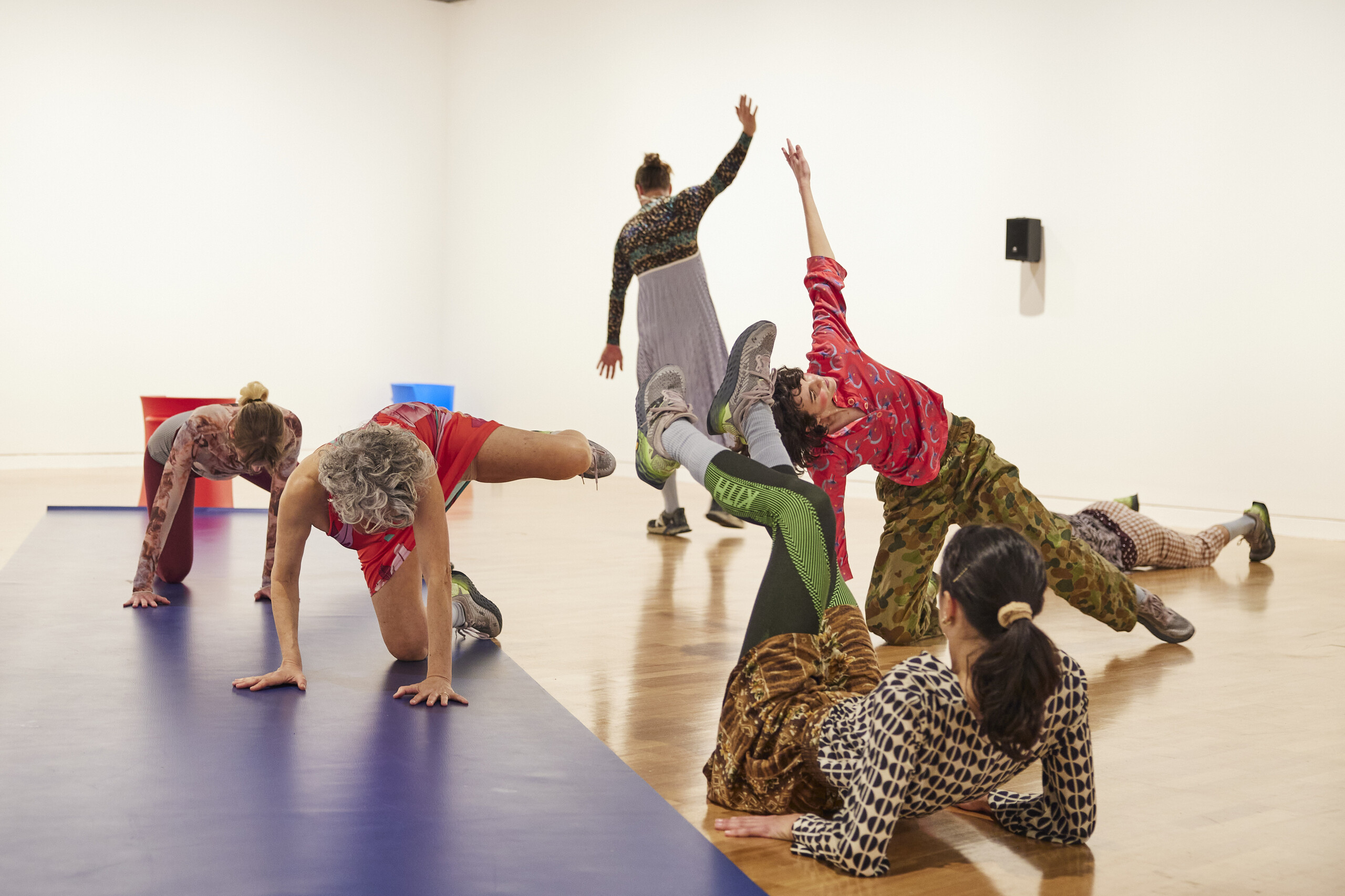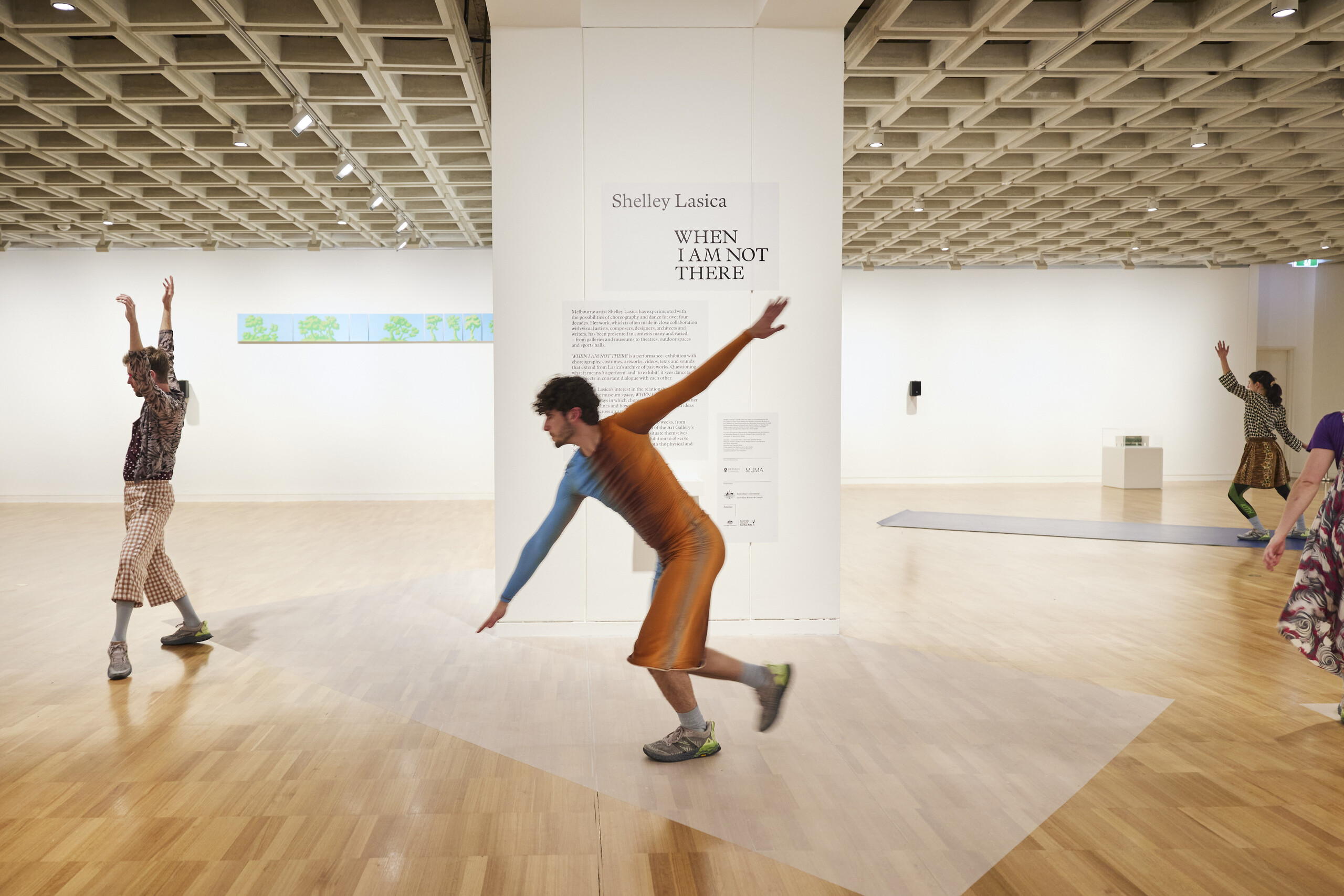Shelley Lasica, When I Am Not There
Bronwyn Bailey-Charteris
The evening after visiting Shelley Lasica’s performance-exhibition, I carved out some time to finally read Ocean Vuong’s new-ish book of poetry, Time is a Mother. Vuong writes with this simmering intensity that brings a juxtaposition of meanings into line with an unlikely ease. I get caught on this line: “How faithful the memory of a shadow, you think.”
How faithful the memory. How faithful the archive. How faithful the body, I think. Remembering the way Lasica and her dancers seem to play the archive, memories of shadows, un and re–remembered in moments of synchronicity.
A rather unlikely thing happens in Lasica’s durational performance-exhibition. Rather than the contemporary art–coded space of Monash University Museum of Art, the home of the previous iteration of the work, at the Art Gallery of New South Wales the piece is actively enmeshed in the messy world of a monumental state art institution. The piece is slightly awkwardly positioned across two spaces, between the lurid green walls of the Young Archie—a classically hung exhibition of portraits by children inspired by the ever-popular Archibald Prize—and the thumping, boxing-inspired soundtrack of the installation What do We want? by artist Reko Rennie (Wurundjeri/Boon Wurrung Country) in The National 4. Add in a serious-looking guard and an overly keen gallery volunteer, and you have the setting for a highly porous, slightly jarring set of performance parameters.
To this end, with multiple entry points, the work is not sanctioned as capital P Performance, with a clean start and end, or showing times, or, worse, videos of what once was in the space. Instead, the performance and exhibition are concretely fused here, with dancers dancing during the opening hours of the entire two-week exhibition. Up to eight dancers, including Lasica herself, move when no one is watching and also when surrounded by the audience. According to the exhibition text, the movements never repeat. Always finding themselves anew, surrounded by an archival style exhibition of models, costumes, text-based pieces, and other material artefacts from the forty-year rolling archive of Lasica, the dancers are never truly alone.
The archive of objects across the two rooms include a large netted “wardrobe” hanging from the ceiling of perhaps a hundred costumes, forming a kind of textile waterfall in the centre of the space. These costumes are from Lascia’s personal archive, and at times the dancers remove pieces, wear them, and rehang. Other pieces in the space are from artists with whom she has collaborated; for example, costume pieces by Kathy Temin and Shio Otani, paintings by Tony Clark, and a theatre maquette by Roger Wood. The archive that enfolds the live elements of the performance offer conceptual links into and out of the movements presented. In this way, the show becomes most like a classical retrospective of a noteworthy artist. And in many ways that is what this show is. This is the overdue retrospective of Lasica’s generous and collaborative dance practice that has fused choreography and museums for the past four decades.
The performance-exhibition WHEN I AM NOT THERE is but one part of a much larger multi-year collaborative research project, Precarious Movements: Choreography and the Museum, hosted by the University of New South Wales (UNSW) with a loaded list of partner organisations, including the AGNSW alongside the National Gallery of Victoria, Melbourne (NGV), Monash University Museum of Art, Melbourne (MUMA), Tate UK and Perth Institute of Contemporary Arts (PICA). These weighty institutions and the ARC-supported research project enables necessary research into Lasica’s career and the specificities of Australian choreographic realities of dance in the museum. While this is an important research area that sheds light on the work of dance and choreography in museums and galleries from an Australian perspective, it is not the focus of this review. That’s because the research is slightly irrelevant in this setting compared to the immediacy of the audience interactions, and the way the work holds itself inside the multiplicities and competing viewer portals of AGNSW. I am looking to the way the piece itself exists in this leaky container. How does the work reveal, revere, and disrupt the logic of the gallery? When does the energetic kinetic fissure of liveness in the gallery break through, or spill over, into meaningful, bodily material meaning-making?

Here I return to the sting of Vuong’s words, when he ponders how faithful the memory and the shadow can be. It is a relevant reckoning here where the past feels very present. Speaking of shadows, there is a definite echo of the 1960s’ high tide of performance and dance in galleries from the New York avant garde; people like Anna Halprin, Yvonne Rainer, and Simone Forti. At one stage the dancers move into a Forti-esque “huddle,” arranging themselves in a set of poses with interlocking limbs. Holding for a beat, releasing and then reforming. In Forti’s Huddle from 1961, the group similarly comes quietly together to form a scrum-like ball, and one dancer climbs up and over the collection of dancers. This link to the grandmothers of choreography (to Halprin, Rainer, Forti) in the museum also follows the matriarchal line, with a gentle nod to Lasica’s own mother, Margaret Lasica, who was a ground-breaking modern dancer, educator, and choreographer in her own right.
One of the most powerful moments in the part of the performance I witnessed had a similar sense of intimacy and trust as can be glimpsed between the dancers in Forti’s Huddle. After some energetic sequences of flocking and flowing, the group gathered around one of the dancers, who became a kind of living statue. She directed the other dancers to lift and manipulate her limbs, and together the dancers lifted her off the floor, up and over the others, before dropping her again gently to the floor. It reads a little like a trust exercise or warm up, and in a way maybe it doubles as these things, but the overall sensation was the feeling of communality and dancerly conviviality.
The costuming added to this sense. With an eclectic eccentricity the costumes moved between bush walker and raver, pre-schooler and art school heartthrob. In contrast to the colourful costumes at AGNSW, the documentation from MUMA in Melbourne shows a series of mismatched blacks. This Melbourne uniform of blacks made the flocking movements of the group there more cohesive, moving more like a multi-limbed multi-headed hydra in the brighter and whiter MUMA space. Back in Sydney the elegantly mismatching costumes add to the slightly surreal and absurd shock of audience and dancers, who seem to blend into and away from each other. The dancers have a steely sense of repetition and determination, and the audience a mix of bemusement, confusion, interest, and Instagram.
For the general audience viewing the work, I wonder how much of Lasica’s dance historical archive is readable. The room sheet, while beautiful, is frustratingly difficult to navigate, and it is at times hard to conceive of whose works are where and why. Through the lens of an exhibitionary retrospective, the pieces in the rooms seem to be intended as a nod towards the way collaboration has been a formative and key feature of Lasica’s ongoing choreographic practice. However, in the situated reading of these pieces, many of the works in the room seem hard to place, shifting between prop and object. The more successful pieces in the rooms that hold force are the text-based works; for instance, Robyn McKenzie’s simply printed A4 script about a three-way love triangle of mountain climbers from 1999, as well as a video of a seemingly live text editor screen by Jacqui Shelton, where phrases and words appear and are removed with a choreographic sensibility. When I visit, the verbs skimming, fanning, flipping, blurb reading, browsing or locating appear alongside the phrase “in a spectrum of colours, binding floors, or even forgetting, i.e., it was about erasure remembering.”

It is this remembering and erasure that is left as my lingering sensation of the show. Afterwards, the imprinted memories of the performance-exhibition hang around me. While the breadth of Lasica’s career and her collaborative choreographic methods are rightly celebrated in this retrospective-type arrangement, it is the small moments of intimacy and liveness that stay with me. The way one dancer speaks empathetically to themselves, something about a bar and how someone is angry with them. Or the moment where the circles of the twister mat in Callum Morton’s grainy video align perfectly with the circles of one dancer’s shirt. Or when one dancer lays alone thrashing against the ground, while the others pass by her unphased. A gang of storybook thieves parading with matching New Balance.
While durational performance and dance inside the gallery is not a new form, When I am not there ripples through the belly of the historical south building, causing a gentle insistence on liveness, on watching, and on the doing of dance. It is the specificity of instruction, for the dance to go on no matter what, to play out in this space across and through time, that means the work not only reconstructs itself through the seemingly inexhaustible dancers, but through an ever-changing, disappearing and re-emerging engagement with an inquisitive audience. This is the surprise of the archive remembered, faithfully and unfaithfully.
Dr Bronwyn Bailey-Charteris is a Swedish/Australian curator, writer and lecturer currently based in Sydney on Gadigal land. Her expertise is on the poetics and politics of eco-aesthetics and curatorial theory.


